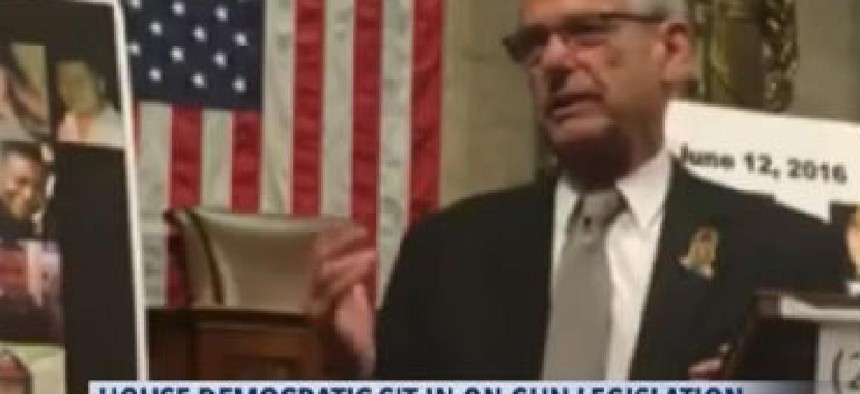Smartphones and video apps powered House Dems' gun control sit-in

House Democrats used social media, personal tech and congressional Wi-Fi to disrupt and bypass the majority's authority, raising the question of how to enforce 18th-century rules of decorum in the Information Age.

Rep. Alan Lowenthal (D-Calif.) addresses the House chamber via a colleague's Facebook stream.
After occupying the House floor for more than 20 hours, Democrats ended their gun control sit-in on June 23.
Democratic members took over the House floor in defiance of Speaker Paul Ryan (R-Wis.), with the stated goal of forcing a vote on several gun control measures. Ryan shut off the House-controlled video cameras that provide the C-SPAN feed, but the public had live video of the whole thing thanks to lawmakers streaming via Facebook Live, Periscope and other smartphone apps. C-SPAN picked up those feeds and broadcast the rowdy scenes to the public.
"It's quite clear we caught them by surprise with our ability to wire around," Rep. Gerry Connolly (D-Va.) told FCW. "I think that the control that Speaker Ryan and his team exercised actually backfired."
The episode shows how the heady mix of social media and personal technology can disrupt long-standing rules of congressional decorum.
"I think the rules are awfully difficult to enforce," Connolly said.
Ryan could have tried to exercise another avenue to limit broadcasting: shutting down the House's Wi-Fi.
A representative from Ryan's office told FCW the speaker had "no plans to turn off Wi-Fi," and Connolly told FCW that, as far as he knew, the wireless access was available all night.
Traditionally, photography and videography are barred on the House floor except for the majority-controlled cameras. Lawmakers typically ignore the rule at events such as the president's State of the Union address, but the gun control sit-in demonstrated how much power members have when they decide to defy decorum for political purposes.
"Given what technology has done, my BlackBerry, my iPhone is now a camera, it takes video, it can pick up audio," Connolly said. If someone's determined to stream video, "how do you prevent that?"
House leaders certainly didn't stop Rep. Scott Peters (D-Calif.), who told Roll Call that House Sergeant at Arms staffers asked him repeatedly to stop streaming video.
Peters resumed streaming after each request due to popular demand, he said.
Rep. Beto O'Rourke (D-Texas) was another lawmaker who took the lead in broadcasting the goings-on by streaming via Facebook and tweeting throughout the night.
"A big lesson of last night's (Periscoped) congressional sit-in was how important robust, decentralized internet platforms are for democracy," cryptographer Matt Blaze tweeted, adding that the event was a testament to "the power of censorship-resistant media."
Facebook founder Mark Zuckerberg gathered several congressional video streams into one Facebook post and credited technology for "bringing us moments we wouldn't see otherwise."
In 2008, Republicans attempted their own sit-in over a different issue, but the event was not broadcast.
From now on, the public can likely expect to see more activity from a lot more perspectives inside the House.
"I think it's hard to put that genie back in the bottle," Matthew Hindman, an associate professor in George Washington University's School of Media and Public Affairs, told FCW.
Smartphones have made keeping photography off the floor an "untenable position," he added, and the "specter of censorship" threatens to undermine any speaker's attempt to assert control.
Even if Ryan had tried shutting down Wi-Fi, Democrats could have set up personal hotspots or used cellular networks to continue most of their transmissions, Connolly and Hindman both said.
And it isn't the first time lawmakers have used technology for political advantage, Hindman added, saying former Speaker Newt Gingrich was famous for appearing on C-SPAN and gained a devoted following. In Gingrich's case, House decorum rules helped him because the C-SPAN cameras did not pan over the empty seats to which he was often speaking.
Hindman said it remains to be seen how important the latest sit-in will be in terms of precedent-setting. But in the short term, Democrats adeptly used social media to gain attention, achieving their stated goal, he added.
House leaders' ability to present the public with only carefully planned images of congressional proceedings is unlikely to survive, Hindman predicted.
"I think those days are over," he said.
FCW staff writer Aisha Chowdhry contributed to this story.
NEXT STORY: Boss of GSA’s 18F Tech Team Steps Down





